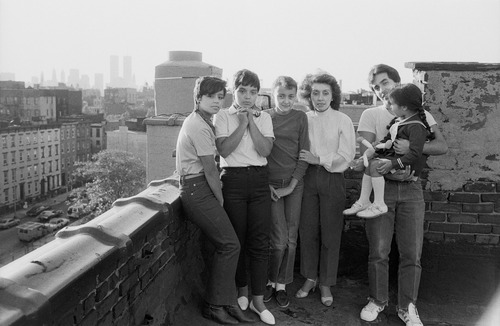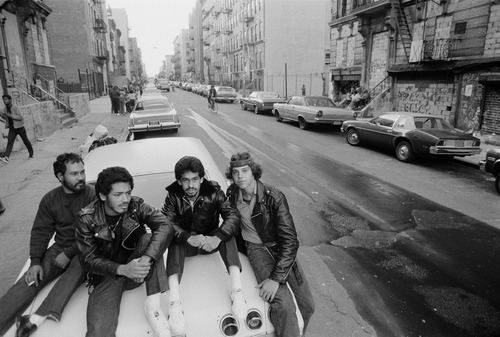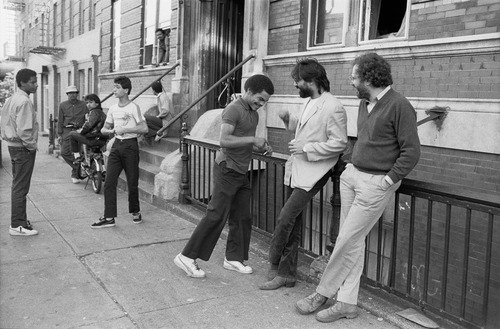
Christopher Allen in Conversation with Luc Sante
For the last five years, UnionDocs, a center for documentary arts in Williamsburg, Brooklyn, has been working to uncover a piece of their neighborhood’s history. It all started with a VHS copy of Diego Echeverria’s 1984 documentary Los Sures. The film, which was nearly lost, takes a look at the Southside neighborhood of Williamsburg when it was one of the city’s roughest. Echeverria did not, however, focus solely on drug use and gang violence. The film also captures the beauty andresilience of the deeply-rooted Puerto Rican and Dominican community, apopulation often overshadowed by representations of Brooklyn in the media today
as a place of over-priced coffee and fixed-gear bicycles. UnionDocs screened
the film in the neighborhood and they were blown away by the response. People
connected instantly. They recognized friends and family, remembered places, and
offered anecdotes about the struggles and celebrations of life in the Southside
throughout the decades.
The response inspired UnionDocs to embark on their
most ambitious project to date, Living Los Sures. With this new project
UnionDocs expands Echeverria’s film into an web-based experience. This includes
thirty new short documentaries about the neighborhood and its residents today,
an interactive feature called 89 Steps that updates the story of one of the
main characters in the film from 1984, as well as a “Shot by Shot”
deconstruction of Los Sures that graphs interviews, archival research,
vernacular photography and video onto individual shots in an elegant interface.
UnionDocs launched Living Los Sures this fall at the New York Film Festival and
are now in the final hours of a Kickstarter to raise the necessary funds to finish the project.
UnionDocs founder and Living Los Sures Executive
Artistic Director Christopher Allen sat down with writer Luc Sante to discuss the project. Sante, author of Low Life: Lures and Snares of Old New York and regular
contributor to the New York Review of Books, grew up in the New York of the
1970s.
I. NOT MUCH HAPPENS IN THE STREETS ANYMORE
CHRISTOPHER ALLEN: A good place to start might be with hidden histories in the
city: places that are overlooked, or places that become almost subconscious in
the narrative. In a way, that is what motivates Living Los Sures.
LUC SANTE: Well, one thing strikes me right away. I don’t know if this a
direct answer to your question, but it stuck out in my mind when this project
came up.
I moved around a fair
amount in my years in New York. I moved to the city in 72. I moved to
Brooklyn in 92. The neighborhoods I moved into were mostly Hispanic when I got
there. To me, one of the emblematic views of 2nd Avenue in Lower Manhattan is
the sight of four Latino guys sitting at a card table playing dominos in the
middle of the sidewalk with the radio plugged into a lamppost. They’re not
holding up traffic, you know, there is no traffic. By the time I had
left these neighborhoods, usually the Hispanics had too. I’m talking
about Columbus Avenue in the 90s and 100s. I’m talking about some of the side
streets between Broadway and the Upper West Side, not to mention the Lower East
Side, or Park Slope when I moved there. These neighborhoods were a lot like the
Southside of Williamsburg, both in terms of population and housing stock,
except that the real estate interest arrived earlier. That’s the major
difference. Otherwise, you had scenes like you see in the film Los Sures,
interactions like this.
So in the film from 1984
[Diego Echeverria’s Los Sures], it’s like you see this neighborhood preserved
in amber. It’s a really exceptional situation. You’re able to project the past
onto the present, and vice versa. You show how people manage to exist and how
they survive through drug addiction and violence and all sorts of things. It’s
really tremendous.
CA: The interplay between present and past has been really
important to us. Actually, early in the project, even the name Los Sures was
new to me and many of us at UnionDocs. We originally titled the project “Looking at Los Sures,” thinking of the film as an document to try to
understand. The thing that we discovered really quickly, was how vibrant and
active the community of Los Sures really was. The “looking at” part of the
title then felt too removed. We switched it to Living Los Sures.
The title was also meant
to reflect a real history of activism in this community. I don’t know if you
saw that where you lived. There was a great deal of organizing. Many of the
buildings in South Williamsburg are co-ops and the Latino population still
exists in this neighborhood because they organized in the late 70s and early 80s to take-over buildings. So they are owners. Anyhow, the point is the
project is not exclusively about the past, about nostalgia.
LS: The thing is, when you talk about the past, it can mean a
variety of things. Not to be a broken record, but this continuity, the fact
that Living Los Sures connects with these same people in the same neighborhood
after thirty years, is a great. I spent a year in Hell’s Kitchen for a fellowship
and I realized that there are still people who’ve been living quietly there for
sixty years. It’s possible to find these people in almost every neighborhood.
There’s always some continuity.
But in South
Williamsburg, it seems like there’s not just a continuity of people but a
continuity of community. Interestingly enough, the night I gave a talk at
UnionDocs there was a block party going on nearby. That’s one thing I remember
very well from all of my old neighborhoods: the block party. Nowadays, you have
these fake block parties. Free samples from neighborhood restaurants and such. In
those days, it was really about the people in the neighborhood. It wasn’t all
about the fancy restaurants or corporations trying to sell you a cell phone
plan. It was about the kids and the grandmothers and local bands. That created
a real sense of community. One of the many things that real estate speculation
has destroyed in New York City is this sense of community. Maybe South
Williamsburg has escaped this. It doesn’t seem to have been wholesale
redeveloped like a lot of places.

CA: I think that’s partially the aspect of local ownership. The
people who were at risk in rental situations have certainly been displaced, but
for people who own it’s a different story. I really like what you were saying.
The film, Los Sures, reveals so many beautiful moments of street life. Moments
around the stoop, moments on the corner. There’s a scene of this couple sitting
on a couch outside of a store like it’s their living room. The buildings in the
film feel more permeable than they do today. You have shots of people leaning
out the window, looking out to the street. Long-term residents will tell you
how this was both a positive and a negative thing. There was someone watching
over the neighborhood, protecting it, but it was the source the gossip, of
paying attention who was doing what with whom.
You are right, on the
Southside, there’s continuity with this today. You still see people playing
dominos, opening fire hydrants in the summer to cool off, and out in lawn
chairs on the block in the evening. People still have a claim to public
space. Despite the real estate market’s destruction of community, it’s not a
done deal.
LS: It’s not a done deal, yes. But, it’s been moving so fast that
it’s remarkable to find a neighborhood like this one. This fall, I taught a
class on cities and photography. We were looking at lots of street
photographers in New York in the 30s, 40s, etc. There are so many pictures of
people leaning out their windows, pictures by Helen Levitt, the Photo League.
People posed on the windowsill with a pillow underneath their arms, with the
sense that they were there all day. And, yes, it was the gossips and it was the
people watching over the streets, but it was also entertainment before
television. It was the greatest TV show of all time watching the block, you
know. There was always something to watch. That’s one of the things I find
distressing about the city as it stands today. Not much really happens in the
streets anymore. You don’t have a street theater of that sort. I remember, even
when I moved from Manhattan to Brooklyn in the 90s, suddenly there was no more
street theater, which I’d come to depend on as light and air and water to me.
You never quite knew what you’d see on the street. There were always public
displays of everything. Now on certain streets if the average income is above a
certain level, there’s none. Even in poorer neighborhoods, it’s just been
notched out a lot. The reason is because of common wisdom about parenting,
because of police activity, various restrictions to people sitting on stoops
for example. People spent 150 years sitting on stoops. Now they can’t anymore?
CA: Now it’s almost suspicious to be a presence on the street. There’s a scene in the film that shows a special relationship to exterior
spaces above the street too. It’s a beautiful shot, one that passes quite
quickly. A woman is on the fourth or fifth floor, lowering down a bag on a rope
and swinging it across the building to a woman on the fire escape of on the
third floor in the building adjacent. Maybe she is getting missing ingredients,
or returning something she borrowed. When we interviewed people about this
shot, it was like, “Oh yeah, these are walk-up buildings. You’d get good
at that to avoid the stairs.” Someone else connected it to how in
highrises in San Juan residents could lower down a rope with a basket to order
groceries from the bodega on the first floor. Then, of course there are kids
who would get the keys lowered down to them in a basket to get in the
buildings, because their parents wouldn’t trust them not to lose them. This
kind of use of the window is definitely not a normal thing to see in the city
today.
LS: That’s fantastic. Also people using clotheslines to ferry
stuff across air shafts to each other. That happened a lot too.
CA: Literal community connections, improvised outside of the
architecture.
LS: Yeah, I remember the keys being a real division. You’d have more
subtle people who’d politely lower them down. Whereas, us kids would roll them
up in socks and throw them down. You’d have to go running after the sock in the
middle of traffic. But you know, locked buildings came in probably mid to late
70s. Before that you could walk into any building in the city and just go
upstairs and knock.

II. UNINTENTIONAL THINGS ON THE EDGES
CA: Would you have been told, “stay away from
Williamsburg,” back then? Or had the sense that it was a dangerous place
in the 80s?
LS: I hate to say this, but in the twenty years I lived there, we
almost never left Manhattan. Really it was the beginning of the late 80s, when
we started knowing people in Brooklyn. Before that it was like, there’s nothing
to see out there. A lot of people are living there, of course, but there’s not
much happening. We’d go to Flatbush to the Jamaican record stores, but not much
else. Williamsburg? I knew of the place, but I don’t think I ever set
foot there until the mid 90s.
But, that said, I’m
totally jazzed by your project. People’s direct physical experience of the city is not something that you tend to find in “history” texts. So, memoirs,
fiction, letters sometimes; this is what I look for. UnionDocs is using oral
history, which is fantastic. But it’s not just oral history, because you have
this undeniable audio-visual anchor to hook peoples memory on to. The way
you are showing people this film and eliciting further memories is fantastic.
It allows different things to come out, because, of course, the past changes
constantly.
People make a fictional
movie set in the past and they get so many things wrong. They get the clothes
right but they’re not the clothes that people actually wore, you know, they
were in Vogue that year. It’s the little things that get forgotten.
The things that people imagine will be remembered hundred years hence become overbearing cliches. Here’s an analogy I used to use: Go into flea
markets, everywhere you go all over the world, you will find these sumptuous Friendship’s
Offerings books, with fancy print jobs, with engravings and pressed flowers
and sentimental poetry. They just flood these markets because no one gives a
shit about them. They were intended to be these fundamental memories but they
are just fancy cliches. Meanwhile, what you want to go after are these little
details that nobody then thought are important because those are the things
that are most connected to people’s daily experiences. It’s because they are so
connected to daily experience that they got overlooked, they didn’t get sold,
they didn’t get preserved by preservationists.
CA: That sounds like very strong advice for the work that’s to
come on this project. We’ve really just scratched the surface of the stories
that are contained in the film Los Sures. We’ve established a nice methodology
for approaching the history, but now we hope to do more of exactly the sort of
research you describe.
LS: When you’ve got a movie the great thing is about movies and
photographs is that things creep into the frame. Whoever’s taking the picture
can only edit so much. There will always be unintentional things on the edges.

See more about Living Los Sures.
Thanks to Bennett Glace for editorial and transcription help.




